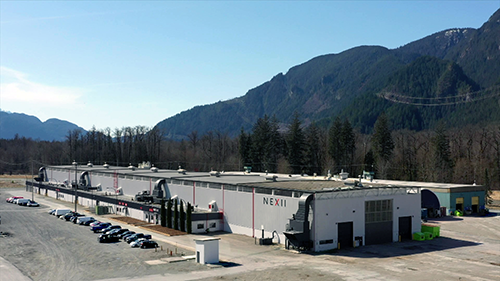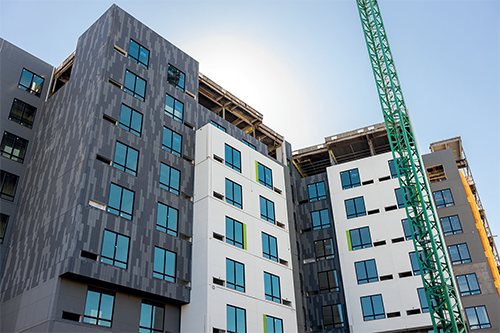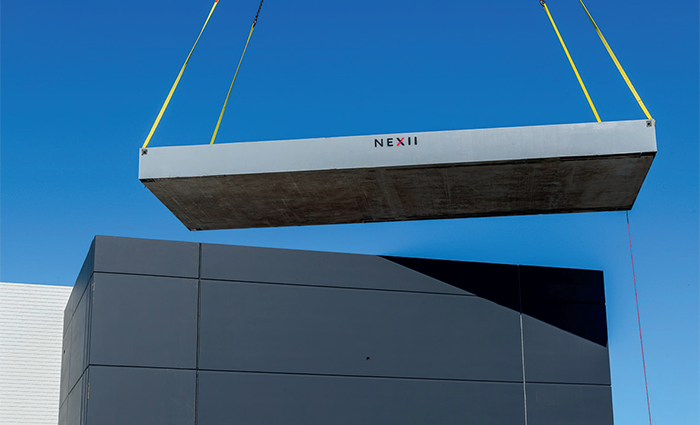Nexii Building Solutions: a guide to green building breakthroughs
The future is green
The construction industry, in its current form, has a significant impact on land, air quality, and water supply. Extraction, production, transportation, and the end-of-life of materials (including embodied carbon) all play a negative role in increasing the detrimental effects the industry has on the environment, particularly in the form of Greenhouse Gas (GHG) emissions.
As reported in the 2019 Global Status Report for Buildings and Construction, 36 percent of final energy use and 39 percent of upstream GHG emissions globally are building-related. Needless to say, something needs to be done.
 Fortunately, however, companies like Nexii Building Solutions (Nexii) exist and want to positively disrupt the industry through science-backed innovation and green construction methods. Gregor Robertson, Executive Vice President, Strategy and Partnership at Nexii, recently sat down with us to talk all things green building, and how the company intends to blaze new trails with groundbreaking and less carbon intensive materials. “Nexii stands out for a number of reasons,” he begins. “First, there is our building process. We precision manufacture our buildings offsite and then rapidly assemble units in situ, reducing build times to a fraction of conventional equivalents. “Our methods are also less carbon intensive,” he goes on. “Nexii walls have an average of 31 percent less embodied carbon than conventional construction, and our builds produce near-zero on-site construction waste. This is all part of the circular economy model that guides the firm; we design for reuse, rather than waste and demolition, creating a circular construction ecosystem.”
Fortunately, however, companies like Nexii Building Solutions (Nexii) exist and want to positively disrupt the industry through science-backed innovation and green construction methods. Gregor Robertson, Executive Vice President, Strategy and Partnership at Nexii, recently sat down with us to talk all things green building, and how the company intends to blaze new trails with groundbreaking and less carbon intensive materials. “Nexii stands out for a number of reasons,” he begins. “First, there is our building process. We precision manufacture our buildings offsite and then rapidly assemble units in situ, reducing build times to a fraction of conventional equivalents. “Our methods are also less carbon intensive,” he goes on. “Nexii walls have an average of 31 percent less embodied carbon than conventional construction, and our builds produce near-zero on-site construction waste. This is all part of the circular economy model that guides the firm; we design for reuse, rather than waste and demolition, creating a circular construction ecosystem.”
As Gregor has alluded to, Nexii designs and manufactures low carbon buildings and products to reduce the climate impact of the built environment – the one in which we live, work, and spend time with our families. With the current industry standards for GHG emissions, a sustainable and scalable solution is not only necessary, but urgently required.
Established in 2019, Nexii has grown dramatically in three short years. Ben and Michael Dombowsky, two inventors and brothers that have worked in the construction industry since the 1970s, knew the status quo had to shift. Over the years, they became troubled by the huge amounts of waste and inefficiency within the industry and, more recently, the evident impact these were having on the environment.
Michael, who now serves as Vice President of Building Technology at Nexii, experimented for many years with various efficient construction techniques before creating what eventually became Nexii’s patented building system. When Stephen Sidwell, the current company CEO, was introduced to the Dombowsky brothers by a mutual friend, all the pieces of the puzzle seemingly came together. The rest is history.
Three years later, the company has gone from strength-to-strength. Last year, Nexii became the fastest Canadian company to ever reach unicorn status and now is valued at $2.05 billion. With over 400 employees and three manufacturing plants in operation, Nexii has the capacity to work with international clients of the highest level.
“Nexii has forged alliances with world-leading brands, including Siemens, Honeywell, Trane Technologies, Pella, and Solar Earth, a prominent solar panel manufacturer,” Gregor details. “By combining our building systems with pioneering technologies, we can make the concept of net-positive energy buildings at scale a reality. At Nexii, we are fundamentally reinventing the way the world builds.”
By reinventing, Gregor means constantly innovating and working on solutions to further decarbonize the built environment. At the core of that mission is Nexii’s breakthrough material, Nexiite, and the Nexii building solution, which enable rapid assembly of high-quality buildings and infrastructure with reduced end-to-end toxins and carbon emissions, near-zero waste, and less disruption to the community.
Gregor is keen to talk us through the firm’s innovative proprietary concrete mix. “Buildings and construction are the number one cause of pollution across the globe,” he asserts. “In addition, concrete is the second most consumed resource; production of the material emits more than two billion tons of carbon each year. As a more sustainable alternative to conventional concrete, Nexiite and Nexii’s building solution cuts construction waste to a minimum, slashes build times, and significantly lowers both the embodied and operational carbon of buildings.
“The mix is comprised of sand, high-quality aggregate, and a binder,” Gregor adds. “This composition facilitates a rapid curing process, attaining higher compression strength faster than concrete. Moreover, it has up to 36 percent lower carbon emissions during production when compared with typical Portland concrete. We use Nexiite in our panels for external and internal surfaces that encapsulate an insulating core and supplement structural reinforcement. This adds more strength to Nexii panels, which weigh 15-to-20 percent less than pre-cast concrete, but are more robust, thus leading to lower costs and a reduced impact for transport, installation, and deconstruction.”
But innovative solutions harnessing the power of Nexiite do not begin and end with building. They go much further. Recently, for instance, Nexii entered a partnership with Siemens to pioneer the future of Electric Vehicle (EV) infrastructure deployment with an industry-first sustainable charging prototype. Together, the two companies created and patented a piece of equipment (VersiCharge XL) that will make installing EV chargers faster, and more cost-effective, while reducing any environmental impacts.
a partnership with Siemens to pioneer the future of Electric Vehicle (EV) infrastructure deployment with an industry-first sustainable charging prototype. Together, the two companies created and patented a piece of equipment (VersiCharge XL) that will make installing EV chargers faster, and more cost-effective, while reducing any environmental impacts.
“The prototype is designed for electrifying fleets and high demand charging applications like football stadiums,” Gregor reveals. “The EV charging prototype design enables quick installation at scale, allowing for fast expansion to meet the growing demand for EV charging infrastructure. Typically, EV charging units would need to be built underground, causing disruption to both the land and the environment.
“However, the above ground design of this prototype allows for minimal disruption to both land and environment and reduces on-site construction waste,” he explains. “The sustainable unit is built using Nexiite, and is developed as a modular design. Overall, it represents the first in a long-term Nexii partnership program that will focus on expanding green building for low-carbon innovations across myriad industries.”
As mentioned previously, Nexii has experienced truly impressive growth. In less than 31 months, the company reached a billion-dollar valuation, and since then it has shown no signs of slowing down.
“We have a number of exciting projects under way across North America, and people can expect to hear about them in the next few months,” says Gregor. “We are focused on scaling up our manufacturing to bring Nexii’s breakthrough products and buildings to more markets, enabling us to better meet the growing demand for green construction.
“Indeed, focusing on the way we build is a key climate solution,” he concludes. “To solve the climate crisis, we need to first solve the challenge of GHG emissions from buildings and construction. These emissions do not just come from heating and cooling, but from the embodied carbon of materials used in construction processes. At Nexii, we are led by our goal to build a vibrant future for people and the planet. Our building products demonstrate that it is possible to use durable, sustainable materials that can withstand deconstruction, reconstruction, extreme weather events, and climate change.”
www.nexii.com
